Fighter in the shape of a bullet. XP-56 Black Bullet
At the same time, the company Northrop, which managed to bring to the series a not ordinary P-61 Black Widow night fighter (Black Widow), was famous for its non-standard projects in the field of creating aircraft and, apparently, the love for the word “black” in the name of the projects. There is nothing surprising in the fact that it was the designers of this American company who designed the XP-56 Black Bullet fighter, which never went beyond the experimental model stage, but still excites the minds of fans aviation its unusual appearance.
For their “bullet”, the designers of Northrop chose the “tailless” scheme, the swept wing, a small short fuselage. The plane also received large air intakes, two coaxially pushing screws of opposite rotation, and a nose landing gear. Externally, the plane produced a real sensation - there was nothing customary in its design for the end of the 1930s of the early 1940s. The internal innovations in the Black Bullet should have been no less - it is enough to note the fact that, for the first time in the aircraft industry, its components and parts were connected using welding, not riveting. Completed the picture is a very powerful piston engine, issuing 2000 hp, as well as weapons, the project consisting of two 20-mm aircraft guns and four large-caliber 12,7-mm machine guns.
The idea for the XP-56 Black Bullet, a single-seat fighter jet, which today is considered one of the most radical aircraft models created during the Second World War, was born in the minds of Northrop engineers back in 1939. Originally designated Northrop N2B, the project was based on a 24-cylinder Pratt & Whitney X-1800 engine with 1800 hp. It is worth noting that even before the outbreak of World War II in June 1939, the US Army began to receive loans for the development of modern weapons, part of the funds were directed to the creation of new fighter models. General Henry Arnold, who was at that time the commander of the US Air Force, applied to the Ministry of Defense for permission to use funds to create a promising fighter with high flight characteristics. This is how the document R40C was born, which regulated the basic requirements for the new aircraft model.
The proposal of the general was approved by 9 February 1940 of the year and already 20 February with the document R40С 7 of American aircraft building companies were introduced. 15 of May of the same year 25 advance projects came to the attention of the US Air Force Technical Commission. After five days of hard work, the commission members chose from the variety three winners who turned out to be: Vultee with V-84 aircraft (in the future XP-54) Curtiss-Wrighte with CW-24B (future XP-55) and Northrop with N-2B (future XP-56). His signature on the contract to develop a new fighter at Northrop was 22 June 1940 of the year. At that time, the Second World War was already raging in Europe, the act of capitulation of France was signed that day, exactly a year remained before the German attack on the USSR. Work in the United States on the creation of new combat aircraft accelerated, including, based on the evolving situation in the world.
Nobody limited the imagination of the designers of the Northrop company, therefore they chose for their promising fighter N2B an unusual aerodynamic “tailless” scheme with pushing coaxial screws of opposite rotation. It was planned to install a real battery of two 20-mm guns and four 12,7-mm machine guns in the fighter-free nose of the engine. In the form of the swept wing of the aircraft, the features of the previous development of Northrop engineers, the N-1M, were guessed. The close affinity of the two projects was also issued by drop-down ailerons for directional control and down-wing tips. The aircraft had a short barrel-shaped fuselage with a protruding cabin, a gargoy and a ventral keel. Externally, the aircraft fuselage really looked like a bullet.
In the role of the main structural material for the new fighter, the developers chose a light magnesium alloy. For the first time in the aircraft industry, construction details had to be interconnected by welding. The engine of the fighter was located immediately behind the cockpit. The N-2B project provided for the installation of an in-line engine with a Pratt and Whitney X-1800 liquid-cooled HP cooling system. Almost the entire volume of the aircraft’s fuselage was occupied by the power plant and the cockpit, so it was decided to place the fuel tanks in the wing. In early September 1800, Northrop assembled a 1940: 1 scale model of a fighter and proceeded to purge it in a wind tunnel at the California Institute of Technology.
At this time, the construction of a full-scale mock-up of the future fighter continued, and the rollout of the flight model was to take place in September of the 1941 year. At this time, John Northrop most worried about the power plant promising aircraft. Pratt and Whitney switched to the development of the X-NUMX-cylinder engine R-18, which had the power of the 2800 hp. At this point, work on the N-2000B project was in jeopardy. As a result of the negotiations, representatives of the company Pratt and Whitney were able to convince the representatives of Northrop to install the R-2 engine on the new fighter. In this case, the motorists promised to take over the full development of the cooling system and gearbox for driving the screws.
At the same time, the use of the new engine significantly worsened the initial design characteristics of the aircraft. The flight weight of the N-2B increased by almost a ton. Despite this, the US military approved the Pratt and Whitney R-2800 engine and sent their changes to the contract in the summer of 1941. Before that, they had time to get acquainted with the scale layout of the future fighter. The overall assessment of the prospective aircraft was satisfactory, at the same time it was assigned the XP-56 index and the name Black Bullet. The construction of the first prototype experimental aircraft was delayed until the beginning of March 1943. The plane left the assembly shop only 20 numbers.
The main part of the cooling system of the fighter was a huge fan. The air for him came through large air intakes of oval shape, located in the root of the wing of the aircraft. Exhaust air then exited from the back of the fighter fuselage through a slot located in front of the propeller screws. This gap was closed with a crown of adjustable doors. Behind, there were two three-bladed propellers of opposite rotation, the diameter of the screws was slightly different (the first was 2,95 m, the second was 2,89 m), the blades of the screws were hollow. To ensure the safety of the pilot during an emergency escape of the aircraft, the propellers could be fired with the help of undermining the installed squibs.
In early April 1943, the XP-56 fighter was transported to Murok. April 6 test pilot John Meers launched the first test runs on the surface of a dried lake. The first ground tests showed that when taxiing at high speeds, the plane began to throw from side to side. The main culprits of this behavior of the aircraft were the brakes of the main wheels of its chassis, as a result they had to be updated. Around the same time, there were problems with the power plant and its reliability, which appeared on the engine bench tests conducted by Pratt and Whitney. As a result, the first flight was postponed and took place only 30 September 1943 of the year.
Impressions of test pilot John Meers about the first flight of the XP-56 fighter were terrible. The car flew at a height of 1,5 meters above the surface of Lake Rogers at a speed of about 270 km / h. At the same time, the pilot had to constantly and with great effort pull the control stick over himself, but at this time the plane always wanted to deviate from the chosen direction of flight. As it turned out, the lowering of the nose of the fighter in flight was associated with the front centering, and the instability of the experimental machine in the direction was due to the insufficient area of vertical surfaces. In order to remedy the situation, the designers of the company Northrop decided to make changes in the alignment of the aircraft using ballast, and the fighter tail surface was increased due to the appearance of another keel on top of the fuselage.
The modified fighter appeared on the 8 October 1943 runway of the year. Before the next flight, the test pilot decided to make several high-speed runs and sorties over the airfield. During the third approach at a speed of approximately 200 km / h, the fighter suddenly spun, the plane rolled over and fell twice. As a result of the accident, the first prototype of the XP-56 Black Bullet was completely destroyed, and by lucky chance Meers got off with only a few bruises. An investigation showed that the rupture of the left strut of the fighter chassis led to an accident.
All deficiencies discovered during the first tests were tried to be eliminated in the second prototype, which was built at the plant in Hawthorn, starting from problems with centering the aircraft and ending with the replacement of the chassis pneumatics. Scheduled for November 1943, the completion of the assembly of the second prototype fighter was postponed to January 1944. Above all else, the aircraft had to change the drive system of the drop-down elevons. The new system included two pipes that were attached to the wingtips. When the pilot wanted to turn the plane in the right direction, he simply blocked the corresponding pipe, after which the air began to flow into a special bellows, which increased in size and in turn moved the lever of the opening of the elevons.
His first flight of the second built prototype fighter "Black Bullet" performed 22 March 1944 of the year. In the sky, the plane raised a new test pilot - Harry Crosby. With great difficulty, he managed to tear the fighter off the ground at a speed of about 250 km / h. To keep the car in the air, the pilot, as before, had to struggle with both hands to pull the control stick towards himself. At the same time, the new course management system was recognized to be quite controllable, although it was too sensitive. The plane slowly gained altitude, engine power was clearly not enough to accelerate the machine with a total take-off weight of about five tons. After 7 minutes after the start of the test flight, the fuel meter failed and Harry Crosby completed the tests.
After 9 days, the plane was ready to make a second flight. At the fighter they changed the position of the center of gravity and were able to eliminate the malfunction of the fuel gauge. During the second flight, Crosby managed to gain the height of 1500 meters. But when cleaning the chassis, the fighter suddenly lifted the nose up, after which the flight speed dropped to just 190 km / h. The pilot decided to immediately release the landing gear back, which helped to stabilize the position of the aircraft in the air using trimmers, and then removed the landing gear again. Upon reaching the flight speed of 320 km / h, Crosby began to notice a strong vibration and noticed a plane’s tendency to fall on the left wing. Believing that a further increase in speed is dangerous, the pilot took the plane to the airfield.
In May, the XP-56 Black Bullet fighter rose four more times into the sky. Each time the engineers of the Northrop company made minor changes in the design of the machine, but they didn’t manage to improve the piloting characteristics of the new product or achieve a higher flight speed. The company's specialists decided to blow the plane in the NACA full-scale wind tunnel, but at that time it was constantly busy with more important research. While the experimental fighter was waiting for his turn, Harry Crosby made several more flights, which revealed another unpleasant feature of the model. The plane had an inexplicably high fuel consumption. In the end, after the execution of the tenth flight, a final decision was made about the termination of all further tests of the fighter and the further development process.
According to the US military, the XP-56 was unable to surpass the fighters of its time, for example, the famous P-47 Thunderbolt. As a result, an experienced fighter was left at Myurok base, where he safely stood for two years. The question of the further continuation of the tests of the unusual machine was raised several times, but without success. In 1946, the XP-56 Black Bullet fighter was finally excluded from the list of aircraft awaiting flight tests.
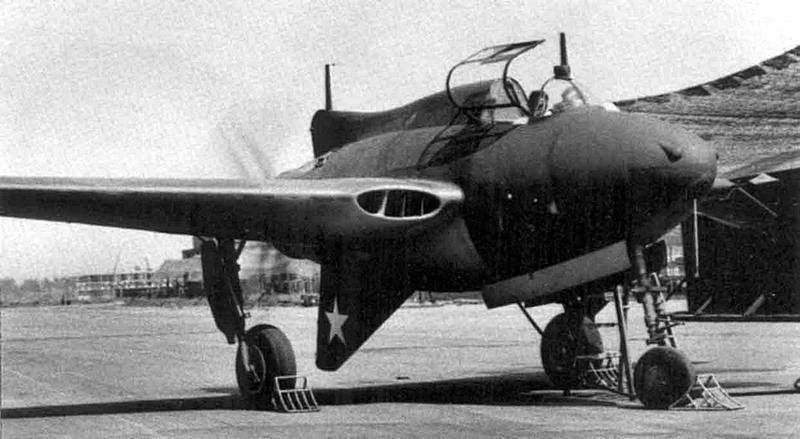
History has shown that a large number of innovations that were laid in the fighter at the turn of the end of the 30-s of the beginning of the 40-s of the last century, led only to delay the creation of a flying sample. From the start of the design work to the first flight, 4 has passed. During this time and the time spent on fine-tuning the car, the military completely lost interest in it. As a result, it all ended with just two prototypes built by the Black Bullet. By the time stated for the fighter's maximum flight speed of 749 km / h, quite traditional North American P-51 Mustang and Republic P-47 Thunderbolt were already selected by that time. Of the two prototypes built, the first one crashed during testing in 1943, the second has survived to the present day and is in the collection of the National Museum of Aeronautics and Astronautics in Washington.
Flight technical characteristics of XP-56 Black Bullet (estimated):
Overall dimensions: length - 8,38 m, height - 3,35 m, wing span - 12,96 m, wing area - 28,44 m2.
Empty weight - 3955 kg.
Maximum take-off weight - 5520 kg.
Power plant - PD Pratt & Whitney R-2800-29 2000 hp
The maximum flight speed is 749 km / h (at altitude), 667 km / h (at ground level).
The flight range is 1063 km.
Practical ceiling - 10 000 m.
Armament - 2X20-mm guns and 4X12,7-mm machine gun.
Crew - 1 man.
Information sources:
http://www.airwar.ru/enc/fww2/p56.html
https://warspot.ru/2936-chyornaya-pulya-ostavshayasya-v-stvole
http://aviadejavu.ru/Site/Crafts/Craft20605.htm
Open source materials
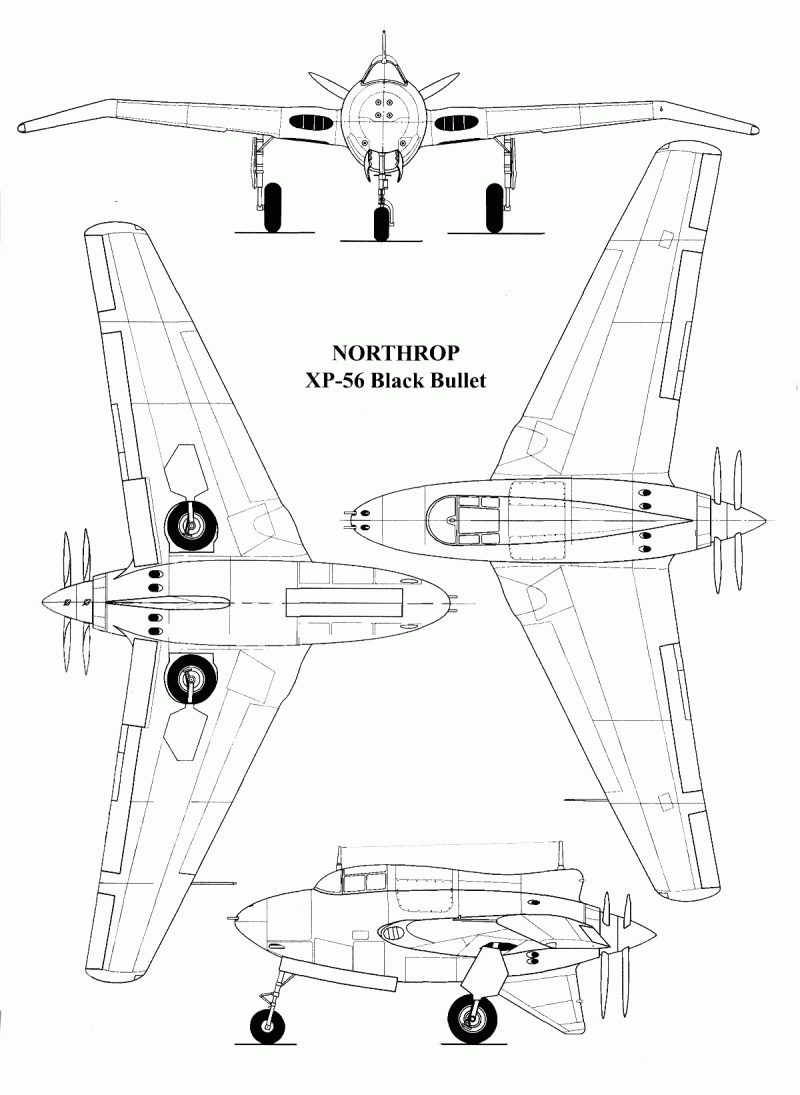
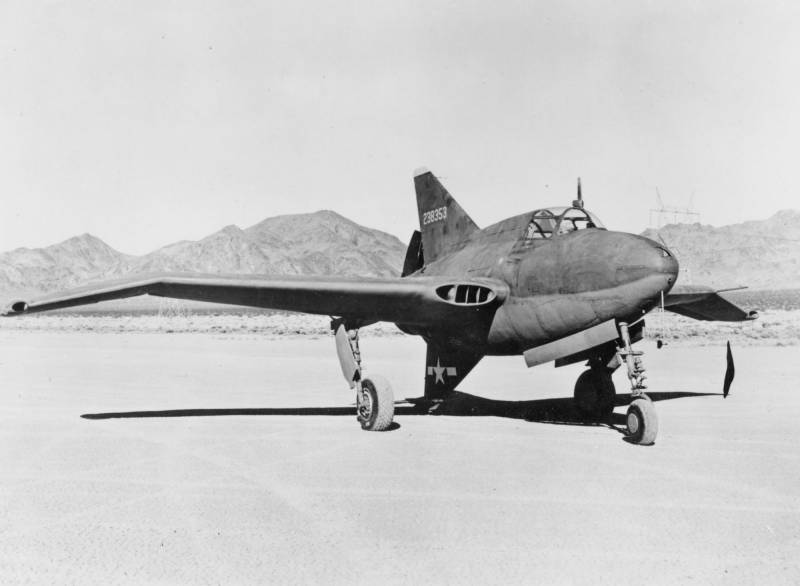
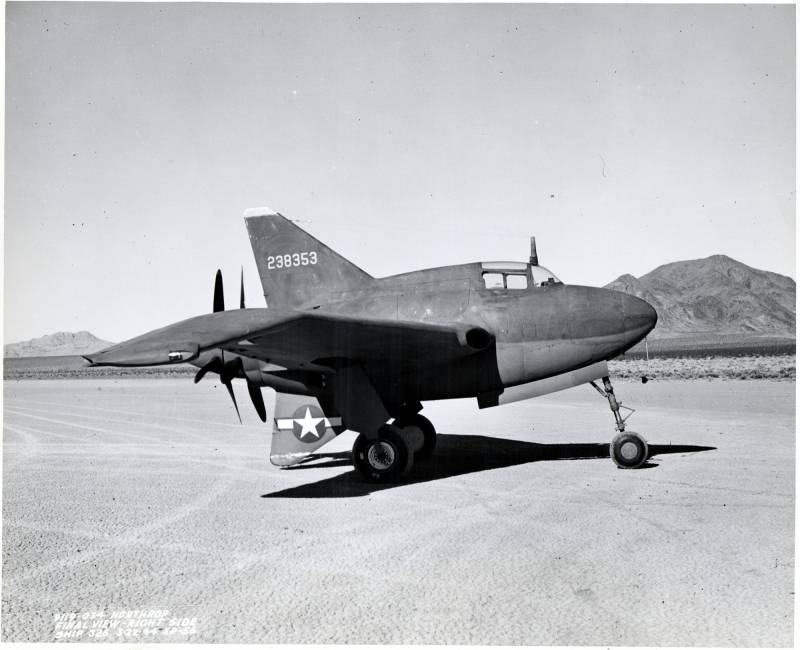
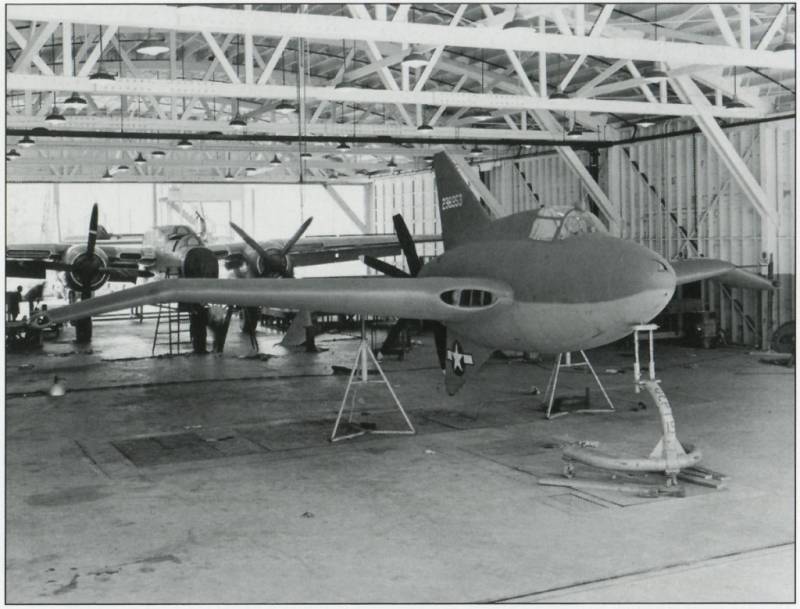
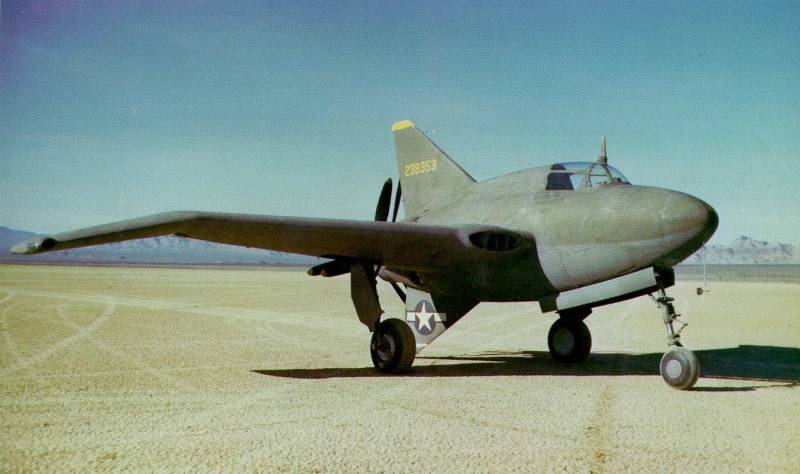
Information